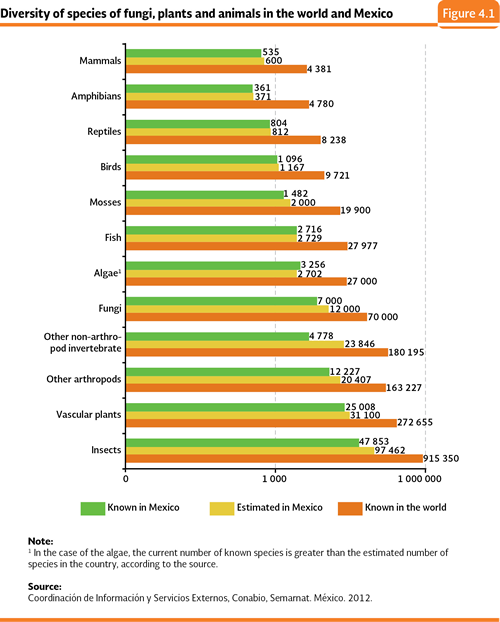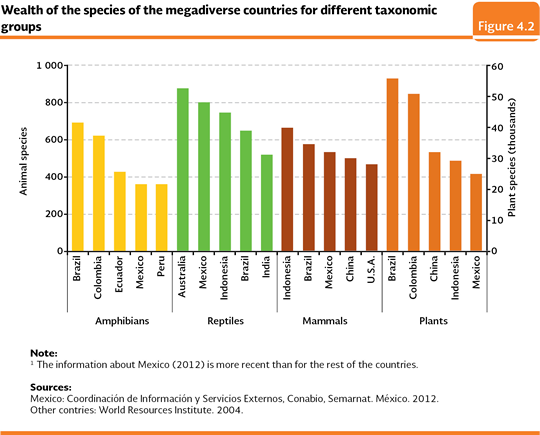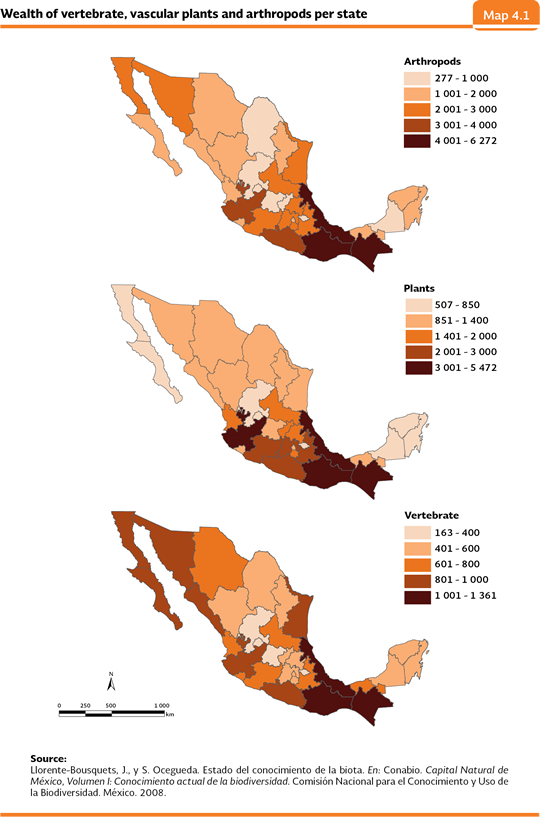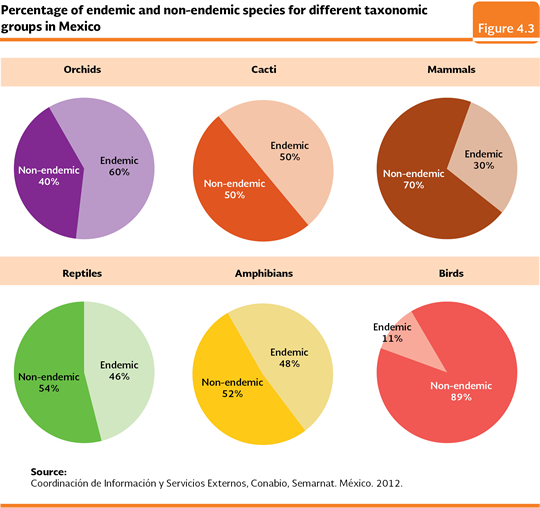
| CHAPTER 4. BIODIVERSITY |
Almost all the types of vegetation that exist in the world can be found throughout the Mexican territory (Conabio 2006); there, thousands of species of diverse taxonomic groups inhabit there, many of which show a large genetic variability. All of this turns Mexico into one of the countries called “mega diverse”, an honor that shares with Brazil, Peru, Indonesia, China and Colombia, among others. Notwithstanding, just like in many regions of the world, the biodiversity of our country faces several and important threats that affect this important natural capital which place under risk their future, along with the environment services which are indispensable for the life and development of the society.
MEXICO, A MEGA DIVERSE COUNTRY Mexico is one of the most diverse countries of the planet from the biological standpoint. Its complex physiography and geological and climatic history, mainly, have created a varied range of conditions that make possible the coexistence of species with tropical and boreal origins, and which have also allowed, over time, an intense diversification of many taxonomic groups in the continental areas of its territory along its coastal and oceanic areas (Espinosa et al., 2008). In this way, in the three levels where the biodiversity is studied (ecosystems, species and genes), Mexico owns a special important wealth. Between 1.7 and 2 million of species have been described in the world as of today, although some studies suggest this figure could increase in the future with the description of new species to a figure between 5 and 30 million (May, 1988; CBD, 2002). In spite of just representing 1.5% of the terrestrial surface of the planet, it is estimated that in Mexico between 10 and 12% of the world species inhabit here. As of today, nearly 65 thousand of invertebrate species are known in Mexico, most of them are insects (around 48 thousand species; Figure 4.1). Concerning the invertebrate, 5,512 species are recorded (which represents around 10% of the known ones in the world); most of them are fish (2,716) and birds (1,096 species). Concerning the reptile wealth, the country is ranked in the world second place (804 species), the third one in mammals (with 535) and the fourth one in amphibians (361; Figure 4.2). Concerning the national flora, Mexico is among the five countries with the largest number of species of vascular plants: a little more than 25 thousand species have been described (most of them are angiosperms: 23,791 species) which is equivalent to about 9.1% of the described species in the world (about 272 thousand).
The biodiversity in the country is not distributed in a homogeneous way in the territory: the studied groups so far, relatively follow the latitudinal pattern of a larger wealth of species towards the Ecuador; certain transition areas stand out because of their wealth and endemism and because it is where the biotas from the Nearctic and Neotropical regions, such as the Neovolcanic Belt and the Sierra Madre Oriental and Occidental come together (Koleff et al., 2008). If we observe the wealth of species per taxonomic group at a state level, it is clear that neither the wealth, nor the knowledge of the species is distributed homogeneously throughout the territory. There are areas which are particularly rich in species where a larger collection effort has been made too: for instance, in the southeast, Oaxaca, Veracruz, and Chiapas are the richest ones at a national level in vertebrate species, vascular plants and arthropods (Map 4.1). Notwithstanding, it is important to note that a large number of vertebrate species in the states of the northern arid areas of the Republic have been recorded.
The species that are just found in our territory, in other words, the endemic species, also complement in an important way, the biological wealth of Mexico. It is estimated that between 50 and 60% of the species of vascular plants known in the country are endemic (Sarukhán, 2009; Table D3_BIODIV02_09). Among them, the orchids and the cacti are some of the families which have a higher percentage of endemic species (60 and 50%, respectively; Figure 4.3). On the other hand, from the 535 species of mammals, 161 are endemic (30% and out of the 1,096 species of birds, 125 are endemic (11%). Now, if the endemism is analyzed by vegetation type, it is found that in xerophilous shrublands and temperate forests, over 60% of the species are endemic, while just 5% of the species of the tropical evergreen forest own this feature (Rzedowski, 1998).
Even though the progress in the inventory of the biological wealth of Mexico has grown meaningfully over the last decades, there is still much to be known. Groups such as the fungi, the terrestrial and marine invertebrate and other microscopically organisms, just to mention some of them, have not fully been collected and studied; besides, the studies in certain geographic areas and ecosystems, as it is the case of the coral reefs and the oceanic depths, have not been exhaustive (Escobar et al., 2009). It is very likely that the figures for many taxonomic groups increase as long as the studies of the national diversity and geography go deeper. The government entity in charge of the activities oriented to promote, coordinate, support and carry out activities directed at the knowledge of the biological diversity, as well as its conservation and sustainable use, is the National Commission of the Knowledge and Use of the Biodiversity (Conabio), which also manage the National system of Information about Biodiversity (SNIB; more details in the Box The National System of Information about Biodiversity). The diversity of the types of vegetation that is found in the Mexican territory is as high as the ones present in China, India, Peru and Colombia. In our country, almost all the vegetation types recognized in the world can be found; these types go from tropical, temperate and mountain cloud forests, until the xerophilous shrublands, natural grasslands and halophile and gypsophile vegetation (Challenger and Soberón, 2008). For more details about the national vegetation and its dynamics in the country, consult the Chapter 2 about Terrestrial ecosystems. The wealth of the ecosystems of the country is not just outstanding in the continental portion of the territory. In the marine area, it can be found open ocean ecosystems and the deep areas (including the cold water reefs), until the communities of sea grasses and coral reefs of warm and shallow waters. In the terrestrial areas, the aquatic ecosystems of fresh water are also diverse, standing out the rivers, lakes and lagoons. Mexico also stands out as one of the countries that have been the origin center of some of the most important cultivated plants for the mankind. It is estimated that slightly more than 15% of the vegetable species consumed in the world are originated in Mexico (Conabio, 2006); from these species, just to mention some, the corn (from which about 59 races are recognized in the territory; Sánchez, 2011), the chile (with nearly 120 varieties) and the bean (from which 63 species are recognized in the world, 52 of them are in Mexico and just five are cultivated; Conabio, 2006). In general terms, it is known that at least 158 species of vegetables of economic importance (either for the world or within Mexico) were domesticated in our territory, standing out, due to its number of species, the family of the Agavaceae (30 species in 3 genera), Fabaceae (22 species in 10 genera), Cactaceae (14 species in 5 genera), Solanaceae (11 species in 6 genera) and Asteraceae (9 species in 5 genera; Conabio, 2012; Table D3_BIODIV05_03). Concerning the animals, there are registered one bird species (the turkey) and one of mammal (the dog), as well as nine species of semi domesticated species1 (the cactus pear cochineal, the red and white maguey worms and the jumiles, among others) for Mexico (Conabio, 2012). At a world level, the genetic variability of the wildlife species is not well known, especially if it is compared to the information we have about its biology or ecology. In Mexico, there are studies about the genetic wealth of about 200 species, which include some microorganism such as the nitrogen-fixing bacteria, pathogens such as the Escherichia coli (which showed the highest genetic diversity ever reported by any organism in the rest of the world), the protozoan Trypanosome cruzi (responsible of causing the Chagas disease) and other species conifer, oaks, epiphytes, cycads, parasites, aphids, birds and marine mammals (Table 4.1, Piñero et al., 2008). This number of studied species is small, especially if we consider the huge diversity that the country hosts.
Note: 1 It is about the fact that the man has intervened in its handling in an incipient way.
|




